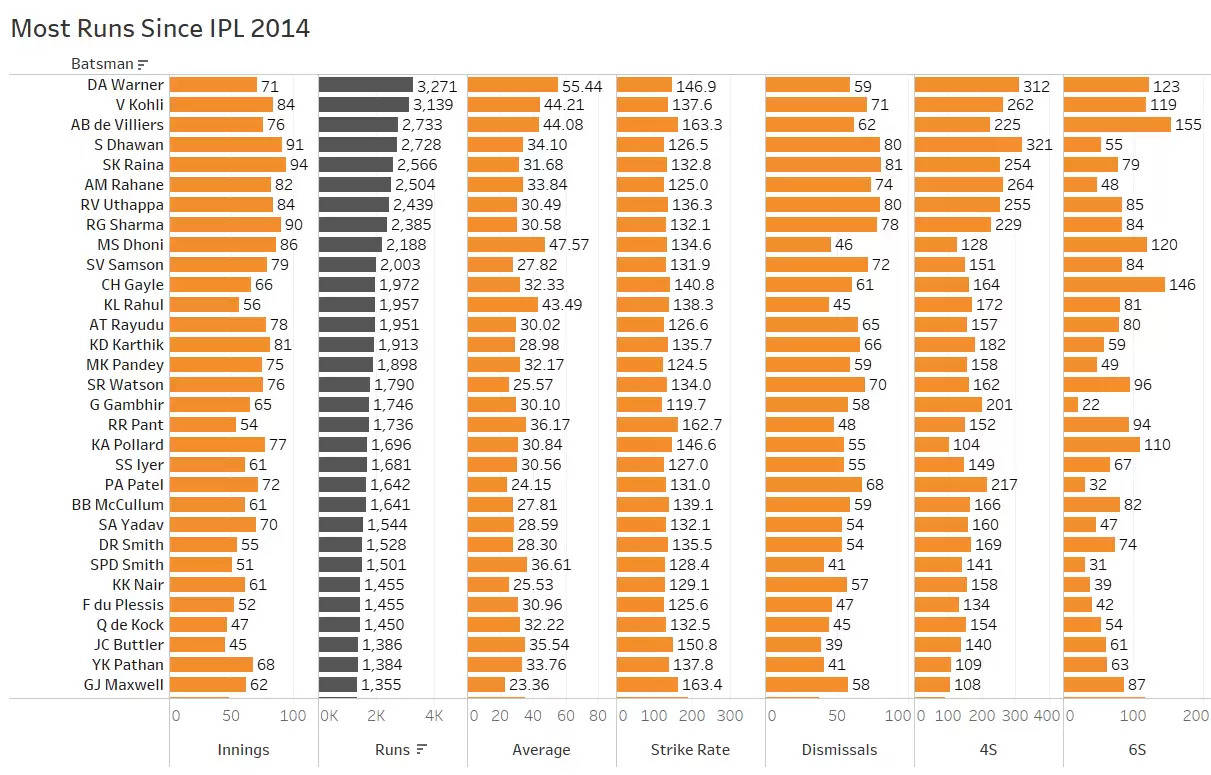David Warner, the IPL maestro at Sunrisers Hyderabad

2014 saw a mega auction that changed the look of all the teams. Sunrisers Hyderabad were at the auction table for their second ever season. They had had a tremendous first season in 2013, winning 10 of their 16 games and reaching the playoffs. SRH recruited David Warner in 2014 for $0.92m and was the sixth most expensive buy of the auction.

Since then, he has been the leading run-scorer in the league, won three Orange Caps (2015, 2017, 2019) and has crossed the 500-run mark in every season he has played in. He has, in short, established himself as an IPL legend. Let us break down his success with numbers.

Since 2014, Warner has the second-best average in the IPL (min 10 innings batted) of 55.4, barely behind Jonny Bairstow’s 55.6 despite batting in 61 more innings. This alone speaks magnitudes of his consistency. Even if we consider RpI (Runs per Innings) as a metric, he leads the list.
 What makes him so consistent? A look into his average and strike rate in each phase of the game would give a better explanation.
What makes him so consistent? A look into his average and strike rate in each phase of the game would give a better explanation.
Powerplay (Overs 1-6): David Warner has batted as opener 60 times since 2014 and has an average of 85, the best in the period by a considerable margin. The next highest average (from an equal sample size) is half as much as Warner – 44 by Kohli.
From his 60 innings, he has been dismissed within the powerplay only 18 times. That means he survives the Powerplay 70% of the time and still strikes at 9 an over.

David Warner in powerplay
There is no visible weakness in his batting in the powerplay. Spin has dismissed him just once since 2014 in the first six overs compared to 19 dismissals against pace. That does not mean he is weak against pace; he averages 59 runs per dismissal against pace.
David Warner in the powerplay sends 23% of the balls faced to the boundary and rotates strike 36% of the time, which means he is scoring off 60% of his balls. The overall figures for a batsman in the top 5 are 20%, 33% and 53% which means David Warner is above-par on all fronts.
As shown in this graphic, David Warner bosses the powerplay. He never goes below run-a-ball and makes the most of the field restrictions. That he does this without compromising on his wicket shows how good he has been at the top.
Middle overs (Overs 7-15):
As expected, right after the Powerplay, there is a dip in scoring rate but as shown that does not mean a dip in average wickets lost. David Warner’s average in the middle overs is 49.5 (fifth best) and his strike-rate of 138 is 14th-best (rises to 6th-best among openers). He has a good record against all bowling types in the middle overs – a healthy average at an above-par strike rate.

David Warner in middle overs
Only 27% of the balls he faces are dots and he rotates strike 59% of the time. In fact, his strike rate from non-boundary balls is 81.32; the only batsmen with a better figure are Rahane, Gill, Gambhir, Kohli and Samson.
Death overs (Overs 16-20):
Generally, in T20 the death overs start from the 16th over. However, from the chart below, we can see that David Warner starts accelerating from the 15th over itself. The graphic below shows his strike-rate and numbers in overs 15-20.
David Warner strikes at 190 in the 15th over and then appears to slow down in the next two overs. However, there is an explanation for slowing down. As the graphic shows, Warner’s dismissal rate peaks in these two overs. Also, the contribution from the other end is crucial in Warner’s numbers at this stage.
Warner’s partners strike at 143 and get dismissed every 13.5 balls during the 16th and 17th overs. In short, SRH’s weak middle order and the loss of wickets at this stage play a big role in Warner’s deceleration in these overs.
It is in the last three overs that Warner completely unleashes himself. He strikes at 225 in the final few overs and scores 72% of his runs in this phase through boundaries.
ALSO READ: Rohit Sharma, the flawless IPL captain
—-
David Warner’s ability to combine aggression and stability makes him one of the best T20 players going around. He rules the powerplay, bosses the middle overs and accelerates at the death. He finds the gaps against pace and maneuvers the field against spin. He hits the ball hard to get boundaries, he deftly places the ball to get those doubles. In a format as inconsistent as T20, his ability to be consistent makes him the needle in the haystack.

